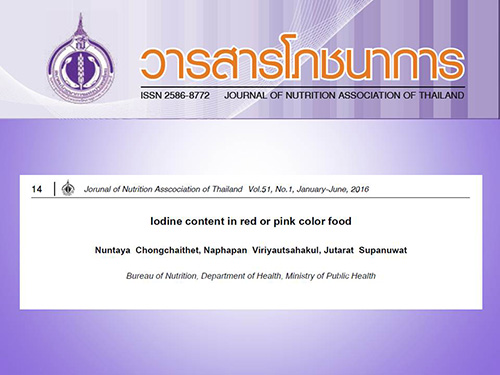Iodine content in red or pink color food
Keywords:
Erythrosine, Food coloring, FoodAbstract
Synthetic food colors available in food industry for attractive consumers. In previous study, found that meat product contented high iodine due to synthetic food color, erythrosine. Iodine surveillance project of department of health showed median urine concentration in preschool children, aged 3-5 years, 224.2, 212.6 and 226.6 ug/l in 2011, 2012 and 2013 respectively. Median urinary iodine concentration of 100-199 ug/l indicate iodine intake adequate and 200-299 ug/l indicate iodine intake above requirement. That mean the children may consume high iodine. This study was conducted to determine iodine content in red or pink foods that preschool like to eat. The food sample divided to 5 categories: sausage and meatball, milk and milk product, beverage, desert and jelly. Collected the food samples from retail shop in front of school and market in Bangkok, Nontaburi, Patumtani and Supanburi. The result showed that pink food contain high iodine such as red or pink sausage, strawberry flavor milk, pink Si-mai desert, pink cake and strawberry flavor wafer. Color testing showed erythrosine in high iodine food samples. Erythrosine composed of 57.7% iodine, thus high iodine content was found in red or pink food samples. So that, Thai FDA and MOPH should recommend food producer about using of synthetic food colors especially erythrosine in sausage and meat product.
References
2. Lee SM, Lewis J, Buss DH, Holcombe GD, Lawrance PR. lodine in British foods and diets. Br J Nutr. 1994;72(3):435-46.
3. Wikipedia. Erythrosine [Internet]. 2014 [cited 2014 Oct 27]. Available from https://en.wikipedia.org/wiki/Erythrosine.
4. The UK Food Guide. E127 Erythrosine [Internet]. Bangkok. 2003 [cited 2015 Feb 25]. Available from: https://www.ukfoodguid.net/e217.htm.
5. Jennings AS, Schwartz SL, Balter NJ, Gardner D, Witorsch RJ. Effects of oral erythrosine (2',4',5',7'-tetraiodofluorescein) on the pituitary-thyroid axis in rats. Toxicol Appl Pharmacol. 1990;103(3) :549-56.
6. จงกลนี วิทยารุ่งเรืองศรี. ปริมาณการใช้สีในขนมเด็กที่จำหน่ายในร้านขายของชำในเขตกรุงเทพมหานครและภาคกลาง. นนทบุรี: สำนักงานคณะกรรมการอาหารและยา กองแผนงานและวิชาการ; 2539.
7. เวณิกา เบ็ญจพงษ์, วีรยา การพานิช, ปิยนุช วิเศษชาติ, กอบแก้ว ขันตี, จารุณี วงศ์เล็ก. การประเมินความเสี่ยงการได้รับสัมผัสสังเคราะห์ผสมอาหารจากการบริโภคอาหารของเด็กนักเรียนในเขตเมืองของกรุงเทพมหานครและเขตชนบทของจังหวัดนครปฐม. วารสารโภชนาการ. 2551;43(4):28-37.
8. ศักดา พรึงลำภู, วิชัย เอกพลากร. ภาวะโภชนาการของสารไอโอดีนในเด็ก. ใน: วิชัย เอกพลากร, บรรณาธิการ. รายงานการสำรวจสุขภาพประชาชนไทยโดยการตรวจร่างกาย ครั้งที่ 4 พ.ศ. 2551 – 2552. นนทบุรี: บริษัทเดอะกราฟิโกซิสเต็มส์ จำกัด; 2553.
9. Moxon RE, Dixon EJ. Semi-automatic method for the determination of total iodine in food. Analyst. 1980;105(1249):344-52.
10. Bradley RL. Dairy products: Solids (Total) in milk. In: George WL, editor. Official Methods of Analysis of AOAC International. 19th ed. Maryland: Gaithersburg, Md: AOAC lnternational; 2012.
11. Kirk RS, Sawyer R. Peasons composition and analysis of foods. 9th ed. United Kingdom: Longman Scientific & Technical; 1991. p. 102-9.

Downloads
Published
How to Cite
Issue
Section
License
Upon acceptance of an article, copyright is belonging to the Nutrition Association of Thailand.


